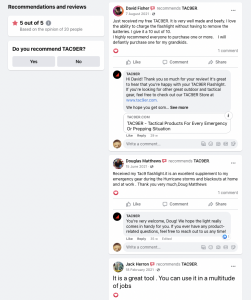How to Get User-Generated Content to Promote Your Ecommerce Business

For years, big brands have spent millions of dollars trying to get the best models, endorsers, and marketers. Turns out, the best kind of promotions come from those you don’t pay for—those created organically by customers who love using your products.
In this article, we’ll look at how you can get more user-generated content to raise brand awareness and revenue even if you’re just a small to medium ecommerce business.
What Is User-Generated Content and Why Is It So Important?
User-generated content (UGC) is any digital content that is created and posted by ordinary people that talks about a certain brand or product. This is in contrast to posts created by the brands themselves. User-generated content is organic and voluntary.
UGC comes in different forms: photos, videos, reviews, etc. That short video your friend posted on her Instagram Story of the hotel she stayed at during her last vacation is user-generated content. And so is that food selfie you saw earlier. These customers weren’t paid to create content for these businesses, but they were unintentionally advocating for them.
View this post on Instagram
The main reason why user-generated content is effective in promotion is its authenticity. According to a study, 90% of consumers say authenticity is important in deciding which brands to support. And UGC feature products or services used by real people in real-life settings, unlike paid endorsers who are expected to say only positive things about the business.
Using user-generated content to promote your ecommerce business makes customers feel like they’re part of your brand, i.e., you’re marketing with them instead of to them.
User-generated content has the following benefits:
- It’s cost-efficient. UGC is generally free because it’s voluntary. There are a few exceptions, such as creating contests with corresponding prizes, but the amount of content it generates is so much more than when you opt for traditional advertising.
- UGC increases conversions and revenue. Word-of-mouth advertising is still the best, and user-generated content is just the digital equivalent.
- It creates trust and increases user engagement. With UGC, customers are not just passive observers. They interact more with the brand and produce honest content.
Examples of Successful Promotions Using User-Generated Content
Let’s look at some brands that have used UGC in their campaigns and what made them successful.
GoPro’s Youtube Videos
As of writing, GoPro’s Youtube channel has 10.6 million subscribers. The channel is filled with videos their customers took using the action camera. The videos appeal to viewers because a lot of them have that wow factor. These GoPro-captured videos include rocket launches, freedives, and close-ups of the inside of live volcanoes.
With this user-generated content available, GoPro didn’t have to film these videos themselves, saving them lots of time and resources in the process. While they did award a total of $1 million for their Million Dollar Challenge, the brand got to engage more users and produce so much more content had they done it themselves.

Coca-Cola Share a Coke Campaign
Various case studies have been made of the Share a Coke campaign because of its success. People want to feel like they’re more than just customers being marketed to, and Coca-Cola came up with the genius idea of incorporating one of the most personal aspects of their customers—their names.
Starbucks White Cup Contest
One of the main advantages of user-generated content is it allows customers to participate and be creative. The Starbucks’ White Cup Contest encourages this by allowing customers to decorate their Starbucks cups using doodles.
How to Create a User-Generated Content Strategy
Just because UGC is supposed to be spontaneous and voluntary doesn’t mean you can just sit there and wait for good things to happen. There are a lot of ways brands can encourage the creation of more user-generated content, some of which are discussed in the next section.
But first, let’s look at the things you should consider when planning your UGC strategy.
Define your campaign’s purpose. If you want more brand awareness, go for hashtag campaigns and contests. If you want higher conversions, ask for testimonials and reviews.
Determine which apps your customers use. There are a lot of social media apps out there. Find out which one your customers use most of the time so you’ll know where to concentrate your efforts. If you’re targeting Gen Zs, TikTok is an effective platform to promote on. For other audiences, Youtube or Facebook might be better.
However, it’s not enough to judge the platform by the number of audience you have. It’s better to focus on apps that have more engagement because remember, you’re aiming for customer participation here.
Consider including prizes or giveaways. Your customers may be more inclined to tag you in an original post featuring your product when there’s a potential for a reward.
Observe what kind of content your customers usually produce. Is your audience more inclined to create videos or are they more likely to post photos of your products? This will help you determine what kind of content to ask for when you’re running a campaign.
View this post on Instagram
For niches with customers that are more likely to take photos, Instagram is a good platform.
Be mindful of your chosen platform.The overall tone and kind of content will depend on the platform. For example, you can be more creative with TikTok, but if you choose to run campaigns on LinkedIn, it has to be more formal.
Prepare content examples. You’re not prohibited from expressly asking your audience for original content. However, don’t just tell customers what you want them to create. Give them examples. Do you want them to take a photo with your product? Show an example. Do you want them to make a short review video? Prepare one to share with them.
Draw up an agreement. Whether your user-generated content is from an unpaid customer or a contest winner who received a prize, it’s wise to create some form of written agreement that expressly allows you to use the content in promotions so you can avoid pesky copyright lawsuits.
When Hashtag Campaigns Backfire
Hashtags are a great way to encourage and filter user-generated content for brand promotions. However, there are a couple of things you need to consider in coming up with your hashtags.
Avoid similarities with sensitive issues. Entenmann's received backlash when they used the hashtag #notguilty after Casey Anthony’s acquittal in her daughter’s killing. Whether it was an honest mistake or they were deliberately taking advantage of the traffic, the damage has been done.
Double-check for sexual innuendos. When Research in Motion wanted to attract more candidates, they used the hashtag #RIMJobs. When Dan Walker tweeted about the Chester Literature Festival he used #CLitFest to promote the event. Maybe they did it on purpose but we don’t need to tell you it's raising eyebrows.
Anyone coming to Chester on 11th October? #Thronkersaurus #CLitFest http://t.co/Jj0nofBQlC on 1
— Dan Walker (@mrdanwalker) September 11, 2014
Think about how customers will respond to your campaign. When McDonald’s launched their #McDStories campaign, they were hoping for positive and inspiring stories. However, an overwhelming majority of those who used the hashtag shared bad experiences with the fast food chain.
How to Get User-Generated Content to Promote Your Brand
Unlike big companies like GoPro, most small ecommerce businesses don’t have $1 million to spare for a contest. The good news is you don’t have to set a big budget to get user-generated content. Here are just a few ways you can encourage your customers to post about your products and services.
Run hashtag campaigns. Choose a catchy and appropriate hashtag then ask your customers to use it when they post about your products. This can go hand-in-hand with giveaways and contests, but it can also stand alone.
Ask for original content. You can outrightly ask your followers to leave a review or post something related to your brand. Then make sure to ask permission before posting and give due credit to your customers. Here are some of the kinds of content you can ask for:
- Before and after photos
- Testimonials
- Personal story
- Lifestyle photos
- Short video clips
Put your hashtag in your page’s bio. Make it easier for customers to tag your brand using your official hashtag by putting it in your bio and including it in posts.

Hold events. When you have the budget, you can host in-person or virtual events. It doesn’t have to be fancy or expensive. The goal here is to build a community, and these events serve as the platform for your customers to meet and interact with one another while using or talking about your brand.
For example, this planner company holds virtual events and announces them in its newsletter.
Engage with customers, even if you don’t feature their content. When you have more than enough UGC, you’ll have to choose which ones to feature, but that doesn’t mean you should leave others unnoticed. As much as you can, interact with customers who took the time to tag you. You can leave a simple thank-you reply or send them a direct message
Make it easy for customers to leave a review. Amazon customers can leave reviews on your product page, but that’s not the only place they can do so. You can include a dedicated page on your ecommerce site for reviews. Some social media platforms such as Facebook also have reviews features.

Improve your products and packaging. This advice requires more work than just social media management, but it’s important to get the fundamentals in. You don’t have to put much effort into increasing your user-generated content when people are naturally inclined to share your product with others just because of how impressed they are with it.
Related Reading: Packaging 101: How to Create Killer Packaging for Your Products Affordably
Final Thoughts
User-generated content is one of the most, if not the most, important marketing strategy out there. In fact, in 2006, Time’s person of the year is You. This is an acknowledgment of the general public’s contribution of user-generated content to the Internet.
Big brands are already working hard towards getting more organic content from their customers. The good news is you don’t have to spend a lot to get UGC—a win for small ecommerce businesses.





